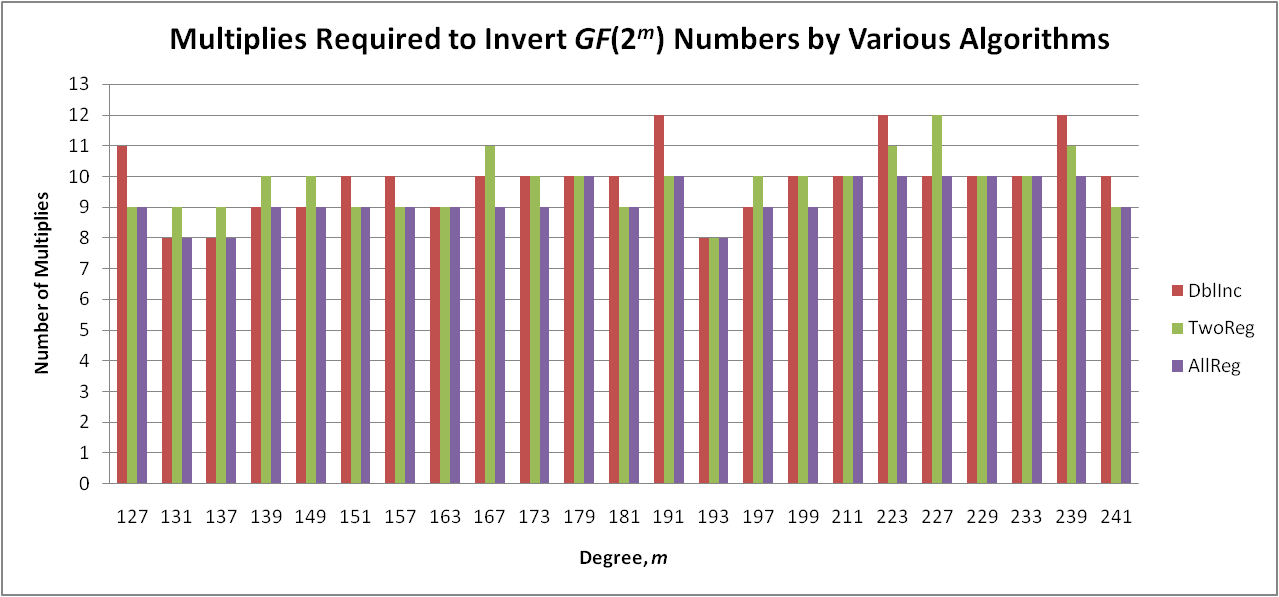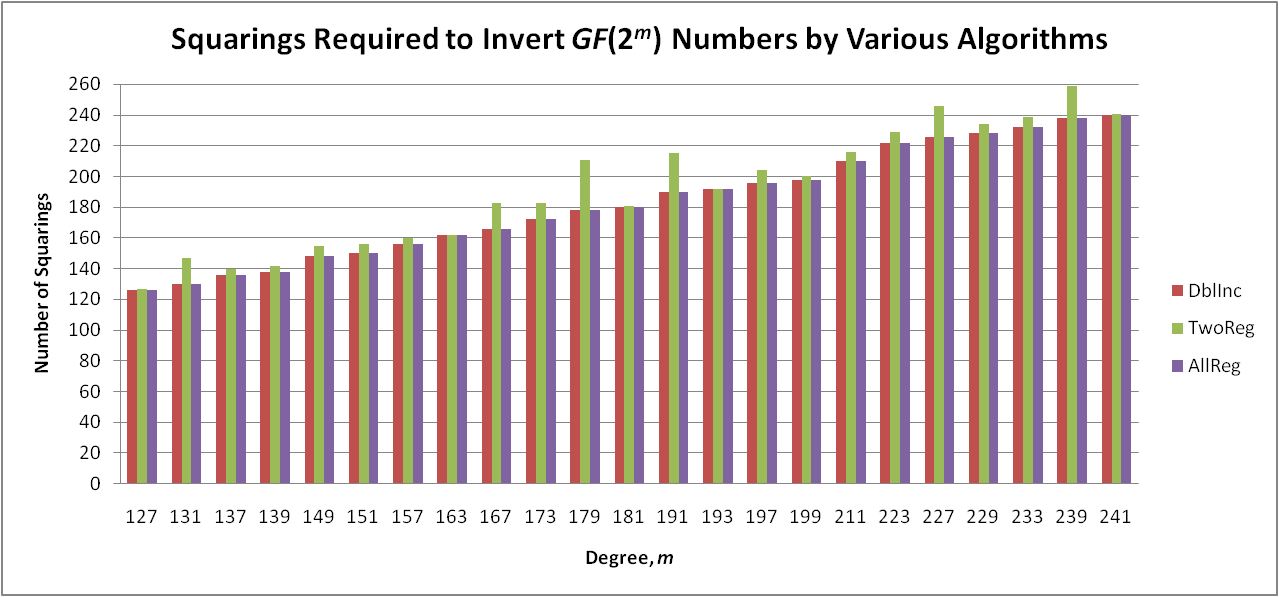Three Register Inversion Paper
Here is an idea for a paper: In an elliptic curve processor like mine
(which has dedicated squaring and needs one dedicated register to hold
a
multiplier
partial product) Itoh-Tsujii inversion takes 4 registers total, but it
can be
done in only 3 registers. The final operation of the encryption process
is the conversion from projective to
affine coordinates that requires dividing the final two numbers. That
is the
only division required. My current solution needs a total of 5
registers: 1 to hold the numerator while the denominator is inverted in
the other 4 registers. Then numerator and inverted denominator
are multiplied together. If I want to get my processor down to 4
registers total, I need to do inversion in 3 registers.
Doing inversion is 3 registers instead of 4 is a simple idea, but maybe
it's not obvious. The simple idea is buried under several layers of
detail, and the idea can be compared to others in terms of execution
time, so maybe it's worth a paper.
To understand the idea, there are several layers to understand:
- Elliptic Curve Cryptography in GF(2m)
- Fermat's Little Theorem
- GF(2m) Exponentiation
- The Itoh-Tsujii algorithm
- Combining Integers
Elliptic Curve Cryptography in GF(2m)
The only important thing here regarding elliptic curve cryptography in GF(2m) is that m must prime. If m were composite it would be
weaker, weaker certainly than the next smaller number that is prime, so m is always
chosen to be prime. A typical number for m is 163.
Fermat's Little Theorem
The theorem says that aq = a (mod q), which says that raising a to the
power q, modulo q, will give a. In the binary extension Galois
field, GF(2m), where values are
represented by a vector of m
bits, q =
2m. So
raising a to the power 2m gives the original number: aq
= a. And if we multiply both
sides by a-2, we
get aq-2 = a-1, which is the
inverse of a. So we can
get the inverse by raising to the power
2m - 2.
GF(2m) Exponentiation
With a dedicated squarer, squaring is a combinatorial circuit and is as
cheap as addition. Multiplying is relatively expensive, having the
same area as addition but requiring O(m) time. Using a dedicated
squarer and multiplier requires one register for the multiplier partial
product. Operands can be read directly out of registers. No temporary
registers inside the multiplier are needed for operands.
To perform exponentiation, we can perform operations on a particular
base number, raised to various powers. Squaring has the effect of
doubling the exponent, shifting the exponent to
the left by one bit. Multiplying two numbers
that are exponentiations of the same base has the effect of adding the
exponents. So an algorithm to raise a GF(2m) number to the power 2m - 2 using
squaring and multiplying is the same as an algorithm for forming the
number
2m - 2 by shifting
and adding.
Itoh-Tsujii Algorithm
The interesting thing about this algorithm is to look at 2m - 2 in
binary. For example, if m
= 5, then 2m - 2 in
binary is 11110. In
fact, 2m - 1 in
binary is m one bits, and 2m - 2 = 2 × (2m-1 - 1). If we
raise a number to the power 2m-1
- 1, then we can square it one more
time and get the power 2m
- 2. So first we need to raise it to the power that in binary has
m-1 one bits.
The insight of the Itoh-Tsujii algorithm, though I don't know if they
thought of it first, is in raising to a power that is all one bits in
binary. Their idea is if you want to get a number with double the
number of one bits, shift a copy of it and add it to the original
number. So if you have 1111 and want to get 11111111, just shift
1111 to get 11110000 and add to get 11111111. As I said before,
shifting here is squaring a GF(2m) number, and adding here is
multiplying two GF(2m) numbers. The goal is to
get an exponent with
m-1 one bits, then square one
last time to get 2m
- 2. But m-1
isn't likely to be a power of two itself, so you can add a single "1"
to the exponent by shifting the number and adding one. So to get 11111
from 1111 and 1, just shift 1111 to get 11110 and add 1 to get 11111.
This is really a double and add one algorithm on the number m-1 itself
(while squaring and multiplying GF(2m) numbers). Looking at the
binary form of m-1, the
number can be formed from left to right. The left-most significant bit
is one, of course, then this is doubled and then optionally one is
added if there is a one in the next most significant bit position of m-1. This is repeated, introducing
bits of m-1 from left to
right until m-1 is formed.
Combining Integers
If forming the number m-1
is the goal, the doubling and adding one algorithm, call it "dblinc,"
is
not
necessarily the most efficient algorithm.
At this level, the problem has been reduced to combining binary numbers
composed of all one bits. If two numbers have i and j one bits, respectively, the
combination with i + j one bits is formed by shifting
the first number left by j
bits and adding the second, or by shifting the second number by i bits and adding the first.
Again, shifting (by one bit) is squaring in GF(2m), and adding is multiplying
in GF(2m).
In the doubling and adding one algorithm, the "one" is the original
number a1.
Doubling a number consisting of i
one bits can be carried out by adding the number to a copy that has
been shifting i bits, but of
course that requires two registers and the original a1 must be held in a
third register. (My current processor requires two more
registers: the multiplier partial product register and the numerator
held in the fifth register.)
To save a register, we can use only two registers, although this method
does not preserve the original a1.
This alternative design is to add two numbers with i and j one bits respectively, with the
result accumulated in the multiplier partial product register.
The only decision is which of the two numbers, i or j to discard and replace with i + j. The goal is still to form the
number m-1. This
approach, call it "tworeg" uses one less register than "dblinc".
How does it compare in terms of GF(2m) multiply and squaring
operations? It turns out to be very competitive.
Since there is only one operation, adding numbers representing
respective
numbers of one bits, the only decisions in either of these algorithms
is which results to discard to make room for the new result given a
limited number of available registers. A third algorithm, call it
"allreg" would have infinitely many registers, so no results would need
to be discarded. This algorithm sets a lower bound on the
required number of operations. A multiply requires O(m)
cycles and squaring only one cycle, so these algorithms can be compared
in terms of the number of multiplies and squarings, but the cost of
squaring is trivial compared to multiplying.
Results
I carried out tests to compare these algorithms, although "dblincr"
(which needs three registers) is the only real algorithm. To test
the capabilities with two registers ("tworeg") and infinitely many
registers ("allreg") I wrote programs to try all combinations and chose
a combination with the minimum number of multiplies, and secondarily
squarings, to invert GF(2m) numbers for each m, the only interesting results
being with m prime. Since m is a constant in these embedded
processors, the steps needed can be hard-coded. The sequence of
decisions needed for "tworeg" to minimize the number of operations
required for an arbitrary m
might be too complex to build into a small processor.
Graphs of the results are shown below. The
question is: Can this be made into a paper?



